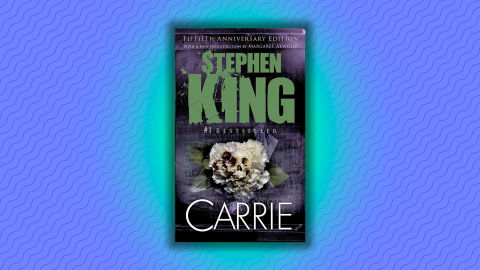Physical Address
304 North Cardinal St.
Dorchester Center, MA 02124
Physical Address
304 North Cardinal St.
Dorchester Center, MA 02124

Although literature might not be the first thing that springs to mind when thinking of the 1970s—that honor goes to bell bottoms, roller disco, and shag pile rugs—plenty of extremely popular books that have stood the test of time were published in the ’70s. Here are 10 iconic books that first hit shelves in 1974 and so are celebrating their 50th birthday this year.
Stephen King’s prolific writing career kicked off with “Carrie”, a part-epistolary novel about a bullied and abused teenage girl with telekinetic powers. The successful novel spawned an equally successful film adaptation in 1976, as well as a few less successful films in later years, and even a failed Broadway musical.
“Carrie” would never have made it into the hands of readers if not for the aspiring author’s wife, Tabitha. King wasn’t happy with the first few pages of the story because, in his own words, he “didn’t know jack-shit about high school girls.” He decided to literally bin the idea, but Tabby rescued the pages from the trash. She told her husband he was onto something and offered to help him with writing about a teenage girl.
“Helter Skelter,” the best-selling true crime book of all time, details the horrific murders of pregnant actress Sharon Tate, her friends, and Leno and Rosemary LaBianca by members of Charles Manson’s cult in 1969. It was co-authored by attorney Vincent Bugliosi, who prosecuted the murderers. In addition to providing the basis for films about the murders, “Helter Skelter” also inspired the 2008 horror film “The Strangers”. Writer and director Bryan Bertino read the book as a kid, but it wasn’t the cult that captured his attention. “I got really fascinated with telling the victims’ tale,” he said, because “none of the victims knew about the Manson family or why it was happening to them.”
Although Steven Spielberg’s 1975 film adaptation of Peter Benchley’s “Jaws” is better-known these days, the novel about the shark with a taste for human flesh made quite the splash in 1974. Not only were the film rights acquired before the book was even published, but it remained on the bestseller list for 45 weeks.
Benchley would come to learn that the rare cases of sharks attacking humans are usually not because they’re looking for a meal. The author became dedicated to shark conservation in his later career, stating that “if I were to try to write “Jaws” today, I couldn’t do it.” This is because the shark “could not be the villain; it would have to be written as the victim, for, worldwide, sharks are much more the oppressed than the oppressors.”
The Watergate scandal—which led to President Richard Nixon’s resignation—was largely exposed by investigative reporters Carl Bernstein and Bob Woodward of The Washington Post. When it came to writing the book about the scandal, Bernstein and Woodward planned to lay out the facts with clinical detachment, but that all changed thanks to a call from Robert Redford (who later starred as Woodward in the 1976 film adaptation, alongside Dustin Hoffman as Bernstein).
Redford told Woodward that the real story wasn’t the cold hard facts themselves, but his and Bernstein’s discovery of those facts. He convinced them that they should be a part of the story, with Woodward later saying that the actor “laid the seed for that in that first phone call.”
Despite being best-remembered for his children’s books, Shel Silverstein wasn’t a fan of the genre: He believed that most literature aimed at kids was condescending. “I never planned to write or draw for kids,” he told Publishers Weekly. It was ultimately editor Ursula Nordstrom—to whom his poetry collection “Where the Sidewalk Ends” is dedicated—who convinced him otherwise. (As Silverstein recalled, his friend Tomi Ungerer—himself a children’s author—“practically dragged” him to see Nordstrom.) Silverstein’s willingness to discuss serious topics, often through the filter of his smart and satiric humor, led to his children’s books becoming staples of the genre. The 1983 audio edition of “Where the Sidewalk Ends” even won a Grammy. (Fun fact: “A Boy Named Sue,” the song he wrote for Johnny Cash, won Best Country Song at the 12th annual Grammys.)
James Baldwin’s “If Beale Street Could Talk” is a heartbreaking love story that highlights the horrors of racism in the criminal justice system. Black couple Tish and Fonny have their lives ripped apart when Fonny is imprisoned after falsely being accused of rape, a situation made more difficult by Tish’s pregnancy.
Although the film adaptation didn’t hit screens until 2018—more than 40 years after the book’s publication—the story is just as timely. Director Barry Jenkins said that Baldwin “was so clear about what he felt was actually going on in America especially as it relates to the lives and souls of Black folks” and that many of “those issues have continued to persist.”
One of less than two dozen books to have won Best Novel in all three major literary sci-fi awards—Hugo, Locus, and Nebula—Ursula K. Le Guin’s “The Dispossessed” is a politically charged sci-fi story. The narrative flips between past and present, following the experiences of a physicist on two planets with vastly different political systems.
In the introductory essay to a collected volume of her works, Le Guin wrote that the novel grew from her “passionate opposition to the war that we were, endlessly it seemed, waging in Vietnam.” She started learning about pacifism and then about nonviolent anarchism, a political philosophy she explored in “The Dispossessed” after realizing “that nobody had yet written an anarchist utopia.”
John le Carré is one of the titans of spy fiction, and “Tinker Tailor Soldier Spy” is one of his most popular books. Unlike Ian Fleming’s James Bond series—which leans into over-the-top action (like 007 fighting a giant squid in 1958’s “Dr. No”)—le Carré’s novels are more grounded. That’s likely thanks to his experience of working for both MI5 and MI6. His day job also had another effect on his books: Le Carré had to use a pen name for his first novel, 1961’s “Call for the Dead”, because, as a Foreign Office official, he wasn’t allowed to publish under his real name. (For the record, it’s David Cornwell.) “Tinker, Tailor, Soldier, Spy” follows spymaster George Smiley as he roots out a Soviet double agent in MI6—a plot inspired by real events within Britain’s Secret Intelligence Service.
On October 13, 1972, Uruguayan Air Force Flight 571 crashed in the Andes. The survivors endured two and half months trapped in the mountains and ate the dead to survive; in the end, 16 of the 45 people aboard the plane made it out alive. Tabloid sensationalism of the tragedy was rampant, but Piers Paul Read’s “Alive” avoided these pitfalls by interviewing the survivors and their families so that the story could be told partly in their own words.
In the acknowledgements of the book, Read admits that “some of the survivors were disappointed by my presentation of their story” because “the faith and friendship which inspired them in the cordillera do not emerge from these pages.” No one but the survivors themselves could have done justice to this aspect of the story, and in 2006, Nando Parrado—who, along with Roberto Canessa, climbed out of the mountains to find help—gave his own version of events in “Miracle In The Andes”, which was co-authored by Vince Rause.
“Blubber”—one of Judy Blume’s most beloved books—is told from the point of view of fifth-grader Jill, who joins in with the bullying of overweight classmate Linda. Blume was inspired by her daughter’s own fifth-grade experience of witnessing classroom bullying. “She was upset by what was going on, but she didn’t know what to do about it,” Blume wrote in an essay included in the 2014 edition of the novel. The bullies in “Blubber” are never punished, leading to the book being banned in certain places for “lack of moral tone.” But Blume defended the ending, saying, “that’s not the way life is. So you have to learn your lessons another way, by becoming sensitive, and by putting yourself in someone else’s shoes.”
Source: Various



